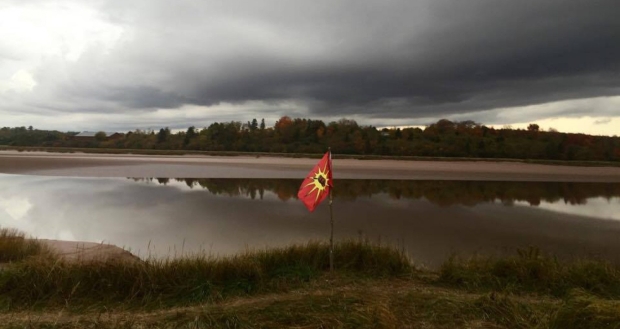
KJIPUKTUK (Halifax) – Just hours after rumours began circulating on social media earlier this month that the Kwilmu’kw Maw-klusuaqn Negotiation Office (KMKNO) supported Alton Gas releasing brine into the Shubenacadie River, that organization issued a news release. “The Assembly does not support the Alton Gas project,” the arm of the Assembly of Nova Scotia Mi’kmaq Chiefs also known as Mi’kmaq Rights Initiative asserted.
Things are never simple, though. Considering the importance that some people assigned to this statement, it is worth looking at the historical record of KMKNO consultation with Alton Gas.
Mi’kmaq protests against Alton Gas lead To 2015 consultation process
Mi’kmaq fishers, with the support of allies, began protests in 2014 about the lack of consultation on the Alton Gas project. Construction was suspended by the provincial government, and that fall a formal consultation process with KMKNO was initiated. After KMK commissioned a third party review amounting to a second environmental assessment, a “technical review” led by Alton Gas began.
During this technical review Alton Gas, as the project proponent, made presentations about the science behind the project, and how it planned to operate. In the course of the review KMK staff requested a change in the draft Monitoring Plan that was to become the core of the Nova Scotia Environment (NSE) Industrial Approval .
The provincial regulator played no role in the consultations, despite knowing that the Monitoring Plan was in practice the subject matter of the technical review.
The federal Department of Fisheries and Oceans (DFO)- in keeping with its long standing nominal position that it is only an advisor and not the regulator of the project, and is not engaged in aboriginal consultations- was the de facto “silent partner” at the table through its continued close work with the Alton Gas lead in the technical review.
Professor Jim Duston of Dalhousie University was also the main author of the Monitoring Plan adopted by NSE, and is a long time professional colleague and collaborator with the two key DFO staffers engaged in the vetting of the project.
Did the Nova Scotia Assembly of Mi’kmaq Chiefs green light the Alton Gas project?
Did the Nova Scotia Assembly of Mi’kmaq Chiefs green light the Alton Gas project? This question was posed in a 2016 article I wrote for the Halifax Media Co-op. Just like today, KMKNO insisted at the time that they had not endorsed the Alton Gas project.
However, it is not the role of the Assembly or KMKNO to endorse or not endorse any project. And with their December 2015 Resolution the Assembly of Chiefs did effectively consent to the Alton Gas Monitoring Plan moving forward, conditional on an annual brining shutdown for striped bass spawning season.
The Monitoring Plan that thus received the go ahead expresses a design of the project that has been thoroughly rejected by Mi’kmaq water protectors and their allies. This same design had been the subject of the consultation “technical review,” and was referred to in the December 2015 Assembly of Chiefs resolution: “KMK has determined that if the project functions as it is intended, the project should not have significant impacts for the Mi’kmaq of Nova Scotia.”
The framework still exists for the KMKNO Alton Gas consultation process that abruptly ended over three years ago- where acceptance of the December 2015 Monitoring Plan was to be the basis for further consultations about how the brine discharge into the Shubenacadie River was to be monitored, and who was going to do that.
Sipekne’katik and Millbrook First Nations take over the Alton Gas consultation process
With the recent formal recognition by the Assembly of Chiefs that Sipekne’katik and Millbrook First Nations have taken responsibility for consultations with or about Alton Gas, the potential that consultations may resume rests with them.
Millbrook Chief Bob Gloade recently suggested that Mi’kmaq have the authority to temporarily shut down the project if deemed necessary once it is completed. This had been discussed in a general way in the 2015 consultations, and before KMKNO withdrew it considered this to be a central part of the next steps in the process.
After his 2016 election Sipekne’katik Chief Mike Sack began discussions of an Impact Benefits Agreement (IBA) with Alton Gas. Early suggestions of what could be included in the IBA were fanciful, but it appeared that by the summer of 2017 some Terms of Agreement had been drafted. This was to have been followed by Alton Gas making a formal presentation to Sipekne’katik Council that included the company covering the costs of a community referendum on whether to accept the proposed Impact Benefits Agreement. From comments at the time by Chief Sack it appears that Alton Gas did not follow through.
During that period of time Alton Gas continued to say that they intended to commence brining operations in the near future and were “in discussions” with Sipekne’katik First Nation.
Throughout all this the government of Nova Scotia maintained that aboriginal consultations were sufficient. The Premier’s Office also stated that Sipekne’katik had always been included in consultations. As far as Premier McNeill is concerned, aboriginal consultation was sufficient to allow Alton Gas to begin operating, with or without a formal Sipekne’katik – Alton Gas agreement .
In other words, Alton Gas could have proceeded without an agreement with Sipekne’katik. But it would be a risky path to pursue, even with that blessing of the government. An agreement with Sipekne’katik First Nation would smooth the way.
On the other hand, an Impact Benefit Agreement that failed to pass a Sipekne’katik referendum would make it impossible for the provincial government to insist that “sufficient aboriginal consultation” had occurred and that Alton Gas was free to proceed. That would effectively be the final nail in the project’s coffin.
Where things stand today
The situation remains the same two years after the stillbirth of an IBA between Alton Gas and Sipekne’katik First Nation: Alton Gas appears to be unwilling to move ahead without some kind of credible agreement with the Mi’kmaq, but finds the path to an agreement too risky.
It is worth noting that if Sipekne’katik First Nation were to rejoin KMKNO, the draft agreement between Sipekne’katik and Alton Gas could re-emerge as a KMKNO Impact Benefit Agreement. Other KMK negotiated IBAs have had a single First Nation receiving the economic benefits. This would end the need for the IBA to face a Sipekne’katik referendum.
Resolutions by Sipekne’katik and Millbrook councils empower the Chiefs of those two First Nations to work with the Assembly of Chiefs and KMKNO “to develop written submissions to Canada and Nova Scotia, as required, respecting the Alton Gas project,” as the press release we mentioned earlier reiterates.
Practically speaking, this is a reference to coming regulatory processes of both levels of government, reviewing once again the adequacy of the previously approved but stalled Shubenacadie River industrial brining process.
The participation of the three aboriginal governments was welcomed by many Mi’kmaq water protectors.
However, this same participation could open the door once again to discussions of economic benefits and shared monitoring of brining the Shubenacadie River.
With a special thanks to our generous donors who make publication of the Nova Scotia Advocate possible.
Subscribe to the Nova Scotia Advocate weekly digest and never miss an article again. It’s free!



